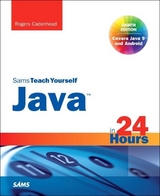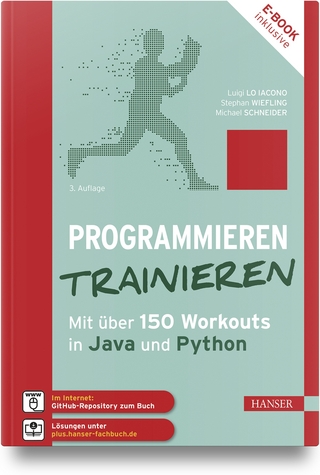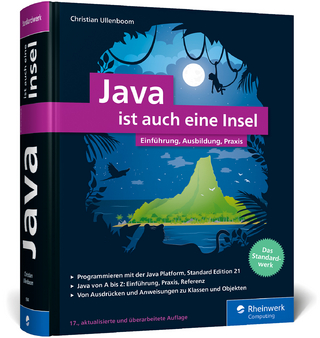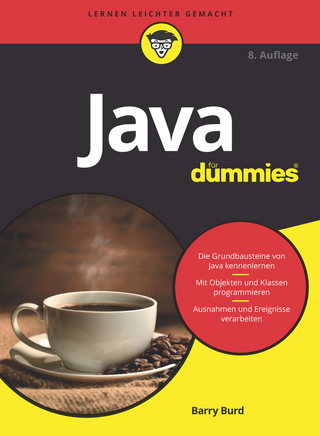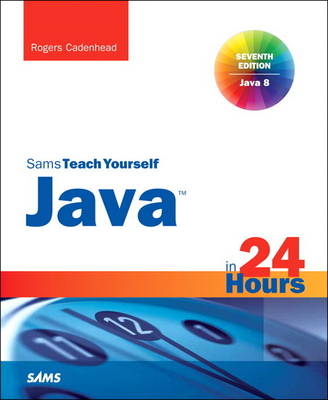
Java in 24 Hours, Sams Teach Yourself (Covering Java 8)
Sams Publishing (Verlag)
978-0-672-33702-4 (ISBN)
- Titel erscheint in neuer Auflage
- Artikel merken
Covers Java 8 and Android Development
In just 24 lessons of one hour or less, you can learn the fundamentals of Java programming.
In this book's straightforward, step-by-step approach, each lesson builds on everything that's come before, helping readers learn Java's core features and techniques from the ground up.
Friendly, accessible, and conversational, this book offers a practical grounding in the language, without ever becoming overwhelming or intimidating. Full-color figures and clear instructions visually show you how to program with Java.
Popular author Rogers Cadenhead helps you master the skills and technology you need to create desktop and web programs, web services, and even an Android app in Java.
Learn how to…
Set up your Java programming environment
Write your first working program in just minutes
Control program decisions and behavior
Store and work with information
Build straightforward user interfaces
Create interactive web programs
Use threading to build more responsive programs
Read and write files and XML data
Master best practices for object-oriented programming
Create flexible, interoperable web services with JAX-WS
Use Java to create an Android app
Expand your skills with closures, the powerful new capability introduced in Java 8
Contents at a Glance
PART I: Getting Started
1 Becoming a Programmer
2 Writing Your First Program
3 Vacationing in Java
4 Understanding How Java Programs Work
PART II: Learning the Basics of Programming
5 Storing and Changing Information in a Program
6 Using Strings to Communicate
7 Using Conditional Tests to Make Decisions
8 Repeating an Action with Loops
PART III: Working with Information in New Ways
9 Storing Information with Arrays
10 Creating Your First Object
11 Describing What Your Object Is Like
12 Making the Most of Existing Objects
PART IV: Programming a Graphical User Interface
13 Building a Simple User Interface
14 Laying Out a User Interface
15 Responding to User Input
16 Building a Complex User Interface
PART V: Moving into Advanced Topics
17 Storing Objects in Data Structures
18 Handling Errors in a Program
19 Creating a Threaded Program
20 Using Inner Classes and Closures
21 Reading and Writing Files
22 Creating Web Services with JAX-WS
23 Creating Java2D Graphics
24 Writing Android Apps
Appendixes
A Using the NetBeans Integrated Development Environment
B Where to Go from Here: Java Resources
C This Book’s Website
D Setting Up an Android Development Environment
Rogers Cadenhead is a writer, computer programmer, and web developer who has written more than 20 books on Internet-related topics, including Sams Teach Yourself Java in 21 Days. He maintains the Drudge Retort and other websites that receive more than 20 million visits a year.
PART I: Getting Started
Hour 1: Becoming a Programmer
Choosing a Language
Telling the Computer What to Do
How Programs Work
When Programs Don’t Work
Choosing a Java Programming Tool
Installing a Java Development Tool
Hour 2: Writing Your First Program
What You Need to Write Programs
Creating the Saluton Program
Beginning the Program
Storing Information in a Variable
Saving the Finished Product
Compiling the Program into a Class File
Fixing Errors
Running a Java Program
Hour 3: Vacationing in Java
First Stop: Oracle
Going to School with Java
Lunch in JavaWorld
Watching the Skies at NASA
Getting Down to Business
Stopping by SourceForge for Directions
Running Java on Your Phone
Hour 4: Understanding How Java Programs Work
Creating an Application
Sending Arguments to Applications
The Java Class Library
PART II: Learning the Basics of Programming
Hour 5: Storing and Changing Information in a Program
Statements and Expressions
Assigning Variable Types
Naming Your Variables
Storing Information in Variables
All About Operators
Using Expressions
Hour 6: Using Strings to Communicate
Storing Text in Strings
Displaying Strings in Programs
Using Special Characters in Strings
Pasting Strings Together
Using Other Variables with Strings
Advanced String Handling
Presenting Credits
Hour 7: Using Conditional Tests to Make Decisions
if Statements
if-else Statements
switch Statements
The Ternary Operator
Watching the Clock
Hour 8: Repeating an Action with Loops
for Loops
while Loops
do-while Loops
Exiting a Loop
Naming a Loop
Testing Your Computer Speed
PART III: Working with Information in New Ways
Hour 9: Storing Information with Arrays
Creating Arrays
Using Arrays
Multidimensional Arrays
Sorting an Array
Counting Characters in Strings
Hour 10: Creating Your First Object
How Object-Oriented Programming Works
Objects in Action
What Objects Are
Understanding Inheritance
Building an Inheritance Hierarchy
Converting Objects and Simple Variables
Creating an Object
Hour 11: Describing What Your Object Is Like
Creating Variables
Creating Class Variables
Creating Behavior with Methods
Putting One Class Inside Another
Using the this Keyword
Using Class Methods and Variables
Hour 12: Making the Most of Existing Objects
The Power of Inheritance
Establishing Inheritance
Working with Existing Objects
Storing Objects of the Same Class in Array Lists
Creating a Subclass
PART IV: Programming a Graphical User Interface
Hour 13: Building a Simple User Interface
Swing and the Abstract Windowing Toolkit
Using Components
Hour 14: Laying Out a User Interface
Using Layout Managers
Laying Out an Application
Hour 15: Responding to User Input
Getting Your Programs to Listen
Setting Up Components to Be Heard
Handling User Events
Completing a Graphical Application
Hour 16: Building a Complex User Interface
Sliders
Change Listeners
Using Image Icons and Toolbars
Tables
PART V: Moving into Advanced Topics
Hour 17: Storing Objects in Data Structures
Array Lists
Hash Maps
Hour 18: Handling Errors in a Program
Exceptions
Throwing Exceptions
Throwing and Catching Exceptions
Hour 19: Creating a Threaded Program
Threads
Working with Threads
The Constructor
Catching Errors as You Set Up URLs
Starting the Thread
Handling Mouse Clicks
Displaying Revolving Links
Hour 20: Using Inner Classes and Closures
Inner Classes
Closures
PART VI: Writing Internet Applications
Hour 21: Reading and Writing Files
Streams
Writing Data to a Stream
Reading and Writing Configuration Properties
Hour 22: Creating Web Services with JAX-WS
Defining a Service Endpoint Interface
Creating a Service Implementation Bean
Publishing the Web Service
Using Web Service Definition Language Files
Creating a Web Service Client
Hour 23: Creating Java2D Graphics
Using the Font Class
Using the Color Class
Creating Custom Colors
Drawing Lines and Shapes
Baking a Pie Graph
Hour 24: Writing Android Apps
Introduction to Android
Creating an Android App
Running the App
Designing a Real App
Appendixes
Appendix A: Using the NetBeans Integrated Development Environment
Appendix B: Where to Go from Here: Java Resources
Appendix C: This Book’s Website
Appendix D: Setting Up an Android Development Environment
| Erscheint lt. Verlag | 5.6.2014 |
|---|---|
| Reihe/Serie | Sams Teach Yourself |
| Verlagsort | Indianapolis |
| Sprache | englisch |
| Maße | 191 x 232 mm |
| Gewicht | 740 g |
| Themenwelt | Informatik ► Programmiersprachen / -werkzeuge ► Java |
| Informatik ► Software Entwicklung ► Mobile- / App-Entwicklung | |
| Informatik ► Software Entwicklung ► Objektorientierung | |
| Informatik ► Software Entwicklung ► Spieleprogrammierung | |
| Mathematik / Informatik ► Informatik ► Web / Internet | |
| Informatik ► Weitere Themen ► Computerspiele | |
| Informatik ► Weitere Themen ► Smartphones / Tablets | |
| ISBN-10 | 0-672-33702-9 / 0672337029 |
| ISBN-13 | 978-0-672-33702-4 / 9780672337024 |
| Zustand | Neuware |
| Haben Sie eine Frage zum Produkt? |
aus dem Bereich
